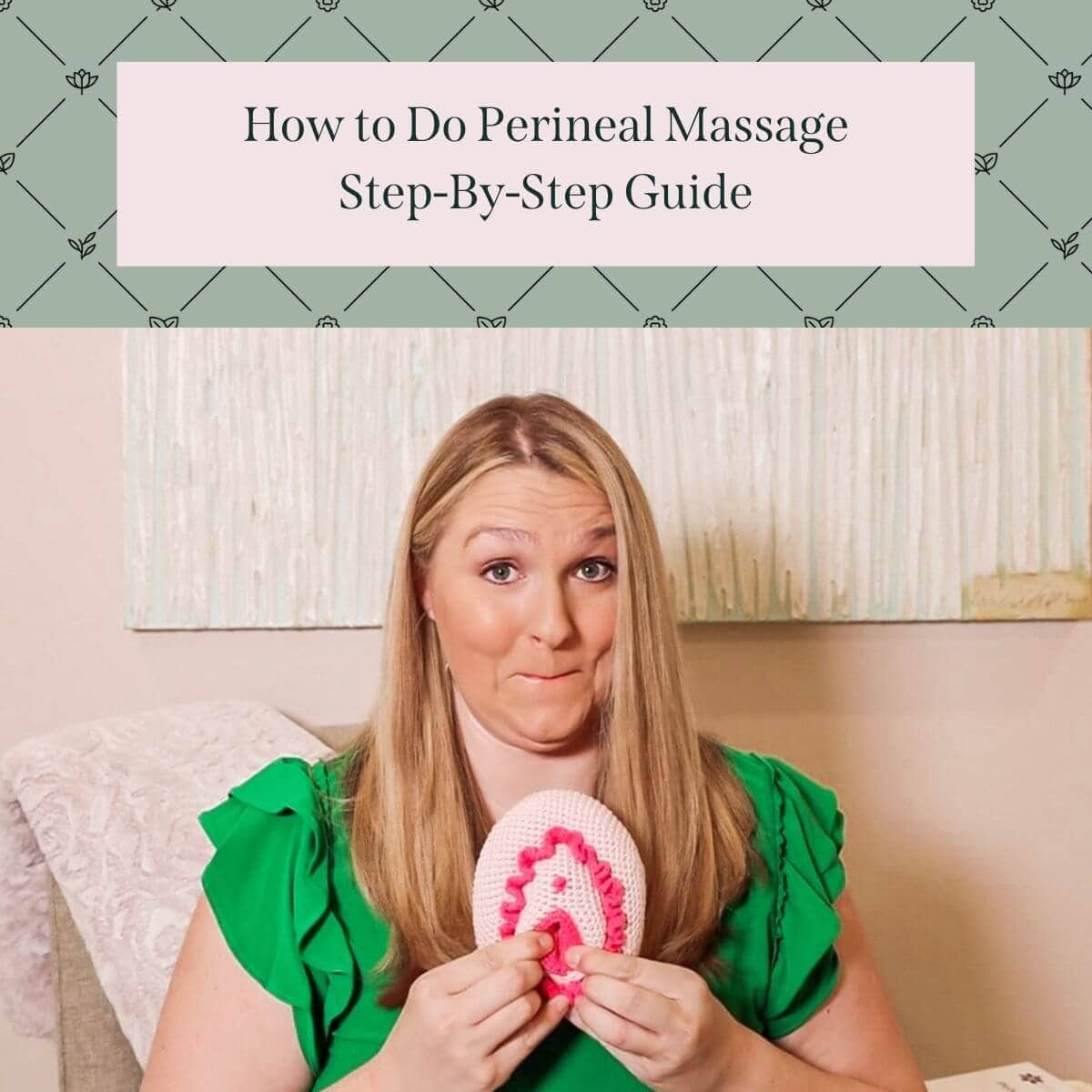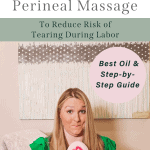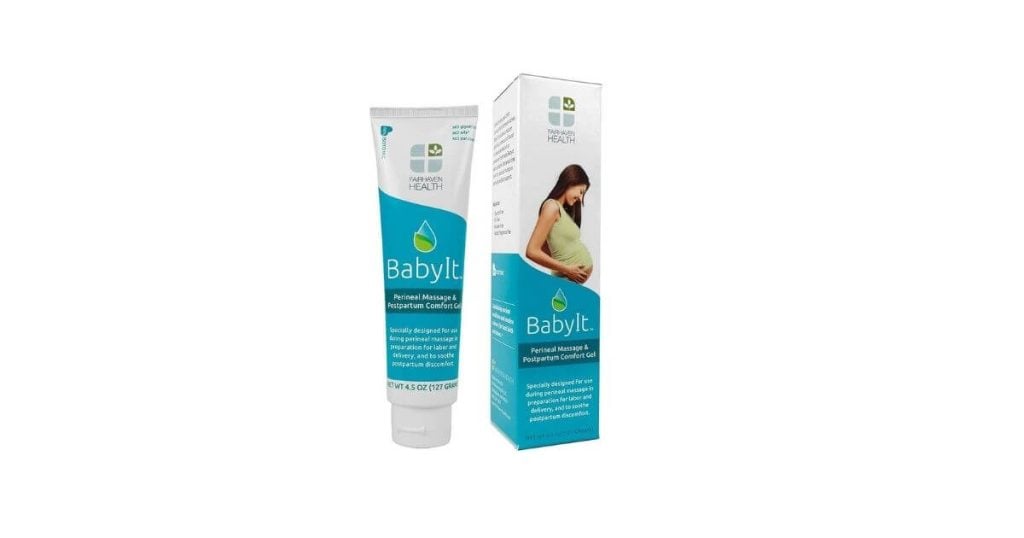Perineal massage can be done easily (in just 5 minutes per day) during the weeks leading up to birth. In this guide, we’ll tell you how to do it step by step, what positions are most comfortable, which oils to use (and why!), and which tools are best.

This site contains affiliate links, meaning that we earn a small commission for purchases made through our site. We only recommend products we personally use, love, or have thoroughly vetted.
- Perineal Massage Positions: How to Reach
- Step-By-Step: How to do a Perineal Massage
- 1. Gather your supplies
- 2. Clean hands or put on sanitary gloves
- 3. Get in your preferred position
- 4. Warm compress (optional)
- 5. Lubricate
- 6. Place your fingers or massage tool at the back of your perineum, where the muscles form a tight, U-shaped rim.
- 7. Slowly massage from the sides to the back of your vaginal canal, near your rectum, and then back to the sides. Repeat.
- 8. Massage slowly for 4 to 5 minutes.
- 9. Repeat daily.
- What is Perineal Massage?
- Can I use Coconut Oil as Perineal Massage Oil?
- How to Breathe During Perineal Massage
- Why Should Perineal Stretching Cause Slight Burning?
- Managing Perineal Massage Pregnancy Expectations
- Perineal Massage In Pregnancy FAQs
Perineal Massage Positions: How to Reach
There are 4 different positions that work well for perineal massage. Which works best for you will depend on a few factors:
- Arm length
- Flexibility
- Comfort in different positions
- Whether a partner is helping
To make it even easier, you can use a perineal massage tool.
Test out these different positions to decide which you prefer. Once you know where and how you’ll be positioned, move on to our step-by-step guide.
A huge thanks to Fairhaven Health for sponsoring this article, allowing us to take extra time and care to do a deep dive into the benefits of perineal massage.This article has been medically reviewed by Merci Treaster, PT, DPT, of The Pelvis Pro.
1. Standing with 1 Leg Raised
Where to do it: In the shower using either a shower stool or bench.
How to reach: Stand flat on one foot while raising the opposite leg onto a higher surface. Then, reach behind your back to easily reach your perineum.

2. Gently Reclined
Where to do it: In bed, lying at a gentle recline propped on pillows.
How to reach: Bend your knees and reach under your belly with your hands or pelvic wand.

3. Squatting
Where to do it: Anywhere you can comfortably squat against a wall with support underneath. A stable high-backed chair is also an option. Please be sure you’re well supported.
How to reach: Sit carefully on your sitz bones with a straight back. Carefully widen your legs, and reach around the underside of your belly to access your perineum.
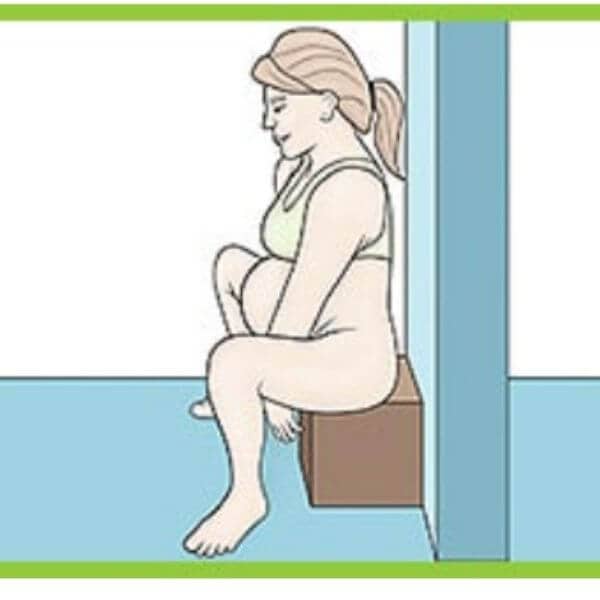
4. Reclined with Partner Support
Where to do it: On the bed and gently recline onto propped pillows or a raised bed with partner across from you.
How to reach: Bend your knees gently. Your partner can sit across from you, facing you, and also with bent knees. This position should allow your partner comfortable access to your perineum.
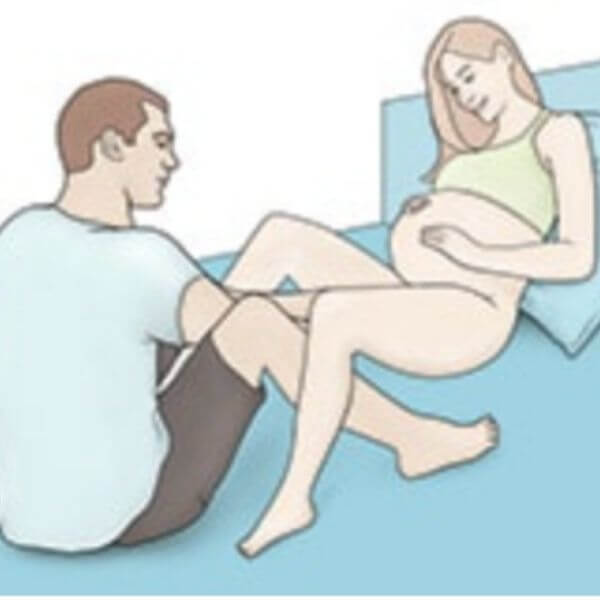
Step-By-Step: How to do a Perineal Massage
Now that you’ve found a comfy position, you’re ready to get started.
1. Gather your supplies
Think of it like the mise en place of massage prep. Gather the supplies you’ll need in the space where you plan to massage. The only required supply is perineal massage gel (not coconut oil or any other household oil. Keep reading to learn why!) All the rest are optional, depending on your preferences.
- BabyIt perineal massage gel
- Pelvic wand/perineal massage tool (makes it easier to reach)
- Warm compress (helps relax perineal muscles)
- Small towel (easy cleanup)
- Sanitary gloves (to keep bacteria out of your vagina)
- Pillows (for comfort & positioning)
Pro Tip: Keep a small bag with the supplies next to your massage space so this is easy each day.
2. Clean hands or put on sanitary gloves
3. Get in your preferred position
4. Warm compress (optional)
Sitting comfortably with deep breaths and a warm compress on your perineum can relax muscles before massaging. While optional and not research-backed for reducing labor tearing, many moms find it makes the massage more comfortable.
5. Lubricate
This isn’t the time to be stingy with lubricant. Whether using fingers or a perineal massage tool, make sure you lubricate thoroughly using a safe lubricant. We recommend BabyIt Perineal Massage Gel.
6. Place your fingers or massage tool at the back of your perineum, where the muscles form a tight, U-shaped rim.
Your goal is to make this firm tissue stretchier before childbirth. By improving muscular flexibility, you’ll decrease resistance in your perineum during labor.
If using your fingers, place the forefinger or thumb (whichever is most comfortable) about 1 inch into each side of your vaginal opening.
If using a massage tool, insert the tip about one inch into your vagina, resting it along the u-shaped rim of your perineum.

Pro Tip: Be careful not to clench your pelvic floor during perineal massage. If your core is firing, so is your pelvic floor, so breathe and relax both. Take deep, 360-degree diaphragmatic breaths as you slowly massage.
7. Slowly massage from the sides to the back of your vaginal canal, near your rectum, and then back to the sides. Repeat.

Your goal is to stretch and widen the U-shaped rim at the back of your vaginal canal.

8. Massage slowly for 4 to 5 minutes.
If you feel an overwhelming burning sensation, decrease the intensity of your massage. If you feel a slight burning sensation, you’re doing it right!
9. Repeat daily.
What is Perineal Massage?
It’s a simple, daily technique that can significantly lower the risk of severe tearing during childbirth. Most vaginal births involve some degree of perineal trauma, with up to 80% resulting in a tear. But there’s a silver lining – perineal massage has been shown to not only reduce the likelihood of trauma but also ease post-delivery pain.
Why do tears happen during labor? Often, it’s due to the baby’s head being too large for the vagina to stretch comfortably, leading to tears of varying degrees. While episiotomies (surgical cuts in the perineum) were once common to prevent tearing, they’re now less favored because they don’t always prevent tears or aid in healing.
Perineal massage works by gently stretching the tissue around your vaginal opening, making it more elastic and ready for childbirth.
Can I use Coconut Oil as Perineal Massage Oil?
Hanging out on pregnancy forums, you’ve probably seen moms suggesting common oils like coconut, olive, or almond oil, or even sexual lubricants for perineal massage. They argue, why buy a specific product when a household item works just as well?
But here’s the thing: these everyday items aren’t as safe or effective for perineal massage. The biggest concern? Irritation. Who needs extra irritation down there when you’re gearing up for childbirth? These oils often contain free radicals, boosting inflammation and irritation risks.
There’s more. Common oils can increase the risk of vaginal infections, and some, like almond oil, have been linked to a higher risk of preterm labor. That’s a definite no-go.
So, what’s the safe choice? We recommend BabyIt perineal massage gel. Designed specifically for perineal massage, it’s paraben-free and avoids harsh preservatives. This gel is isotonic, matching your body’s natural salt levels, unlike sexual lubricants which can be too harsh for the delicate perineal area.
Bottom line: BabyIt provides gentle, balanced hydration, making it the ideal choice for your perineal massage needs.
How to Breathe During Perineal Massage
Proper breathing is key during perineal massage, much like it is in exercise.
Merci Treaster, PT, DPT advises deep, diaphragmatic breathing during the massage. Imagine taking a breath that fills not just your belly but also your sides and back. This is a 360-degree breath. As you inhale deeply, your pelvic floor naturally lengthens, preparing the perineum for stretching.
- Simply sit up straight
- Inhale slowly and deeply, feeling your entire midsection expand
- Gently exhale, feeling a softening and relaxation.
This breathing technique helps maximize the benefits of perineal massage.
Why Should Perineal Stretching Cause Slight Burning?
The purpose of perineal massage is dual: to increase the elasticity of the perineal muscles for easier stretching during labor, and to prepare you for the burning feeling experienced during labor’s transition stage.
Easier said than done, I know, but embrace the burn! It’s crucial for learning to relax and breathe through the discomfort. This preparation helps reduce the likelihood of tensing up during labor, which can increase the risk of perineal trauma.
Despite the initial discomfort, which usually eases after a week or two, perineal massage is highly valued. According to a study in The Lancet, over 75% of women who learned it correctly planned to use it in future pregnancies, and 87% would recommend it to friends. These numbers speak volumes about the effectiveness of perineal massage.
Managing Perineal Massage Pregnancy Expectations
Perineal massage isn’t the most comfortable, but shouldn’t be painful. Pain suggests overstretching, causing pelvic muscle tension, which is counterproductive. Expect some discomfort and a burning sensation, which helps prepare for the ‘ring of fire’ during delivery. This practice teaches you to breathe and relax through discomfort, easing your labor and delivery experience.
Perineal Massage In Pregnancy FAQs
Most practitioners recommend 3-4 weeks before baby is expected to arrive, and some say to start even earlier. “I encourage my patients to do perineal massage starting at 34 weeks of pregnancy,” says Dr. Peter Rizk.
The area between the vaginal opening and the anus. More than just skin, it’s connected to muscles crucial for childbirth and daily activities.
If you experience an uncomfortable burning sensation while performing perineal massage, you can feel confident you’re doing it correctly. Extremely painful burning is a sign that you’re using too much pressure, while no burning sensation indicates you aren’t effectively stretching your perineal muscles.
Lubricant is crucial for perineal massage. Using common household oils like coconut or olive oil isn’t recommended due to risks of irritation and infection. Instead, choose a product like BabyIt perineal massage gel, specifically designed for this purpose, paraben-free, and isotonic to match your body’s natural conditions.
For best results, practice perineal massage daily. As it becomes more comfortable over time, it shows effective relaxation and stretching of the perineum, preparing your muscles for labor.

